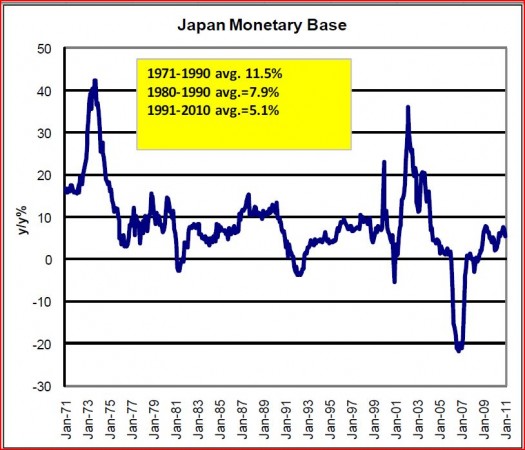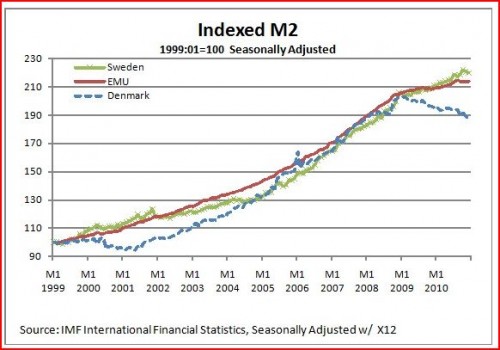Connect the dots
Part 1: A new study by Martin Feldstein estimated that QE2 created an extra $2.5 trillion in stock market wealth for Americans. It should be noted that foreign markets also rose sharply in anticipation of QE2, so my $5 trillion estimate from last year for world gains may be on the low side. (US stock wealth is about $17 trillion; world stock wealth is closer to $50 trillion.)
To be sure, there is no proof that QE2 led to the stock-market rise, or that the stock-market rise caused the increase in consumer spending. But the timing of the stock-market rise, and the lack of any other reason for a sharp rise in consumer spending, makes that chain of events look very plausible.
The magnitude of the relationship between the stock-market rise and the jump in consumer spending also fits the data. Since share ownership (including mutual funds) of American households totals approximately $17 trillion, a 15% rise in share prices increased household wealth by about $2.5 trillion.
I conservatively assumed a 10% gain on $50 trillion, whereas Feldstein assumed 15% on $17 trillion. Either way, the world gained a lot of wealth.
Part 2: In August (right before rumors of QE2) Paul Krugman argued that pressure from outside pundits was one of the only ways to move that stubborn mule called the Fed:
So why am I even slightly encouraged? Because the critics did, at least, succeed in moving the focal point. Not long ago gradual Fed tightening was the default strategy; but as I said, at this point the Fed realized that continuing on that path would have unleashed both a firestorm of criticism and a severe negative reaction in the markets.
What we need to do now is keep up the pressure, so that at the next FOMC meeting the members are once again confronted by the reality that not changing course would be seen as dereliction of duty. And so on, from meeting to meeting, until the Fed actually does what it should.
I know: it’s a heck of a way to make policy. In a better world, the Fed would look at the state of the economy and do what was right, not the minimum necessary. But wishing for that kind of world is like wishing that Ben Bernanke were running the place.
And it worked!
Part 3: Last month Ryan Avent published the following observation over at The Economist.com:
I SEE that Scott Sumner is taking a victory lap of sorts””not unearned””over the fact that views of monetary policy have come full circle since the years before the crisis. Once upon a time, the Fed was viewed as having near-absolute power over the path of the economy. Then crisis struck and many argued that the Fed had run out of ammunition and fiscal policy was required. Eventually people began arguing that the Fed could do more and should do more, thanks largely to the efforts of Mr Sumner himself.
“So what you’re saying is . . .”
I’m not saying anything, just reporting news from the blogosphere.
Part 4: Off topic, but I am complete burned out, and have been for months. I’ve blogged an average of eight hours a day, seven days a week, for over two years. I’ve only kept going in recent months out of a sense of obligation to keep pushing these issues. But now that lots of other people are saying the exact same thing, it’s time for me to take a break. So I’ll stop blogging for a few months, unless there is some huge news story like QE3, in which case I’ll add a couple posts. Or if someone does a hit job on my marshmallow post, I may need to briefly respond. Otherwise I’m done for now, and will return sometime this summer.
I hoped my school would give me some support for blogging, but that’s not how things work in the real world. Perhaps I could find a way to make some money and buy out a few courses. I was thinking about ideas like writing a macro version of Freakonomics, or doing speaking engagements, or perhaps even consulting.
Please don’t tell me that so and so does even more blogging than me while teaching; I’m not so and so. Here are a few reasons I’m taking a break:
1. Like corrupt politicians resigning under pressure, I need to “spend more time with my family.” Indeed I might want to spend a few minutes with my 11 year old before she graduates from high school. And then there is my long-suffering wife.
2. More time to actually read a few books for pleasure, or see some films.
3. I do have a job.
4. The blog has spun off a lot of activities that you don’t see. I read lots of papers that people send me, do more speaking than before, conferences, etc. I hope to get my book out this year. Maybe I can write some papers.
I thought about cutting back, but blogging is like a drug addiction for me—it won’t work. Better to go cold turkey for a while.
Of course all the other quasi-monetarists (Rowe, Beckworth, Woolsey, Hendrickson, Kantoos, etc) will continue to cover the same sort of topics that I discuss. On the progressive side, Yglesias is very good on money. Don’t overlook Marcus Nunes, who contributed greatly to my blog, and also has his own blog now. His views on monetary policy are quite close to mine.
I suppose I naively thought that if my blog was successful then support would magically turn up somewhere. But let’s face facts, most people outside the blogosphere view what we do as a cute hobby, like growing miniature Bonsai trees, or raising chinchillas for fun and profit. For all you young academics out there, the “Wisconsin Idea” is dead; it’s all about the pubs. But do it anyway; it’s the right thing to do.
PS. You’re probably thinking Avent exaggerated this blog’s importance by a factor of 100, because he’s a nice guy. I agree. So go redo the math and tell me what I’m worth.
PPS. I’ll occasionally look at the comment section. Long-time commenters can always ask me questions about current events, and I’ll try to give a quick reaction.
PPPS. Christina Romer is now my official spokesperson on all matters relating to monetary policy and payroll taxes.



